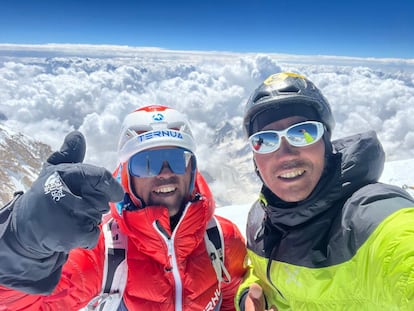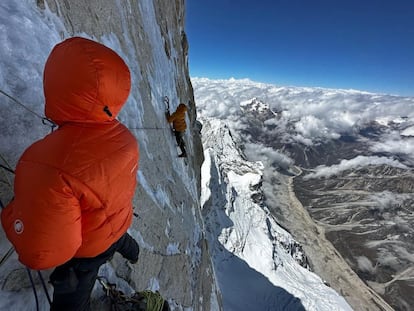Why mountaineering will never be a sport
Amid the Olympic Games in Paris, the deaths of Kazuya Hiraide and Kenro Nakajima on K2 sheds light on the wild essence of an activity in which mistakes are paid for with lives

As the Olympic Games take place, mountaineering timidly embraces the precepts of high performance, pretends to imitate sport, but the deaths of its protagonists remind us with stubborn abruptness that climbing remote mountains is a wild gesture, without rules, referees, or spectators. It is not a sport, and may never be. In Paris, people can watch the weeping of men and women who fall short of their medal dreams live or on demand. No one witnesses the failure of a mountaineer, no camera captures the terrible moment of an accident, of a fall, of an avalanche that determines the game is over and that death will prevent a repechage. This summer K2 has resembled an Olympic stadium. On the one hand, no one had ever climbed the second-highest mountain on the planet (8,611 m) so quickly: 11 hours was invested by the French magician Benjamin Védrines from base camp, by the same route from which its tremendous summit was conquered in 1954. Unlike the pioneers Lacedelli and Compagnoni, Védrines is a machine trained with the severity of a cyclist. Where everyone experiences the agony of hypoxia and fears the objective dangers (falling rocks, ice masses), Védrines flies as though dressed for a stroll up Mont Blanc. He could wear a track athlete’s number and no one would be surprised.
On the other side, on the dark western slope of K2, far from the new mountain tourists, far from everything, even from life itself, Japanese climbers Kazuya Hiraide (45) and Kenro Nakajima (39) were facing the challenge of their careers: they considered their trajectory permitted them to try one last big dream — a fearsome one, certainly — one last trip before returning to being like everyone else. The west face of K2 is actually a rock face rising almost 3,000 meters and has only been climbed once, in 2007, by a Russian platoon of 23 dedicated climbers. The two Japanese mountaineers have twice won the prestigious Piolet d’Or, the award that distinguishes the most innovative and daring climbers. But the pair had never been rock climbers, nor were they particularly adept at high-difficulty mixed terrain, so no one knew quite what route they planned to tackle in alpine style.
Looking at photos of the western slope as if it were a jigsaw puzzle, one can see on the left side a succession of snowfields interrupted here and there by rock walls: it is the easiest route, although it is obviously exposed to the fall of snow and rocks. It was the route chosen in 1988 by the Pole Wojcieck Kurtyka and the Swiss Jean Troillet, two climbers who wished to measure themselves against the formidable challenge in alpine style. Just like this summer, the weather then turned out to be horrendous and the pair spent 56 days at the foot of the mountain without seeing a single day of sunshine. In the end, Kurtyka and Troillet launched two attacks on the mountain but in both cases they did not get beyond 6,400 meters, seen off by the avalanches that swept across a route they christened the Sickle, given the shape of the corridor along which they intended to progress.
After weeks of waiting, the long-awaited window of good weather reached K2 on July 24: all the climbers set off up the slope, none as fast as Védrines, of course. Two days later, a couple of Pakistani army helicopters were searching for something on the west face. They immediately came upon two figures in the snow, motionless. Hiraide and Nakajima were still in the same position two days later: something had caused them to fall from an altitude of around 7,000 meters. Since it was impossible to get to them from the air (army aircraft are not equipped for such a difficult rescue), there was speculation about organizing a rescue from the ground, an idea that soon faded away, leaving the Japanese couple for dead. Kazuya Hiraide could have attempted Védrines’ record: he was always a physical prodigy. But he wasn’t interested: “Normal mountain routes don’t give me the experience I’m looking for,” he admitted last December during a visit to San Sebastián.
Much more than a sport, Hiraide and Nakajima’s mountaineering was a game of exploration, of cunning, of unknowns, of compromise dotted with uncontrollable parameters where fortune had an important specific weight. Outsmarting the vagaries of the terrain. To be quick when necessary. Not to make mistakes. Not to underestimate the mountain or overestimate your own abilities. The more Hiraide grew as a climber, the better he got to know the mountains and the more fear they instilled in him: “Now that I’ve had so many experiences, I know exactly how terrible the high mountains can be, I know their traps better and that’s why I fear them. I need someone strong by my side like Nakajima to have confidence in my abilities,” he explained a few months ago in a disconcerting speech devoid of the ego of mountaineers. Ultimately, elite mountaineering is a permanent struggle against the fear of the unknown, against inner demons.
In recent days, a team of mountaineers from Pakistan was able to recover the body of the high-altitude porter Muhammad Hassan, sadly famous after suffering a fall last summer on the bottleneck of K2, at about 8,450 meters, and dying before the eyes of all those who considered it more important to reach the summit than to help him. Almost at the same time, a Russian group went to Gasherbrum IV to search for and collect the body of Dmitry Golovchenko, who disappeared when he fell into the void trying to open a new route in the company of Sergey Nilov. Collecting the bodies of fallen climbers in the Himalayas is a last gesture of respect, of empathy with their relatives. It is the symbolic awarding of medals that celebrates not a specific success, but a way of understanding life, however incomprehensible it may be for ordinary mortals.
Sign up for our weekly newsletter to get more English-language news coverage from EL PAÍS USA Edition
Tu suscripción se está usando en otro dispositivo
¿Quieres añadir otro usuario a tu suscripción?
Si continúas leyendo en este dispositivo, no se podrá leer en el otro.
FlechaTu suscripción se está usando en otro dispositivo y solo puedes acceder a EL PAÍS desde un dispositivo a la vez.
Si quieres compartir tu cuenta, cambia tu suscripción a la modalidad Premium, así podrás añadir otro usuario. Cada uno accederá con su propia cuenta de email, lo que os permitirá personalizar vuestra experiencia en EL PAÍS.
¿Tienes una suscripción de empresa? Accede aquí para contratar más cuentas.
En el caso de no saber quién está usando tu cuenta, te recomendamos cambiar tu contraseña aquí.
Si decides continuar compartiendo tu cuenta, este mensaje se mostrará en tu dispositivo y en el de la otra persona que está usando tu cuenta de forma indefinida, afectando a tu experiencia de lectura. Puedes consultar aquí los términos y condiciones de la suscripción digital.










































